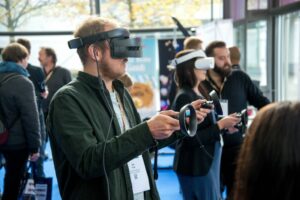This is part one of my series of how to create an online course. The aim of this series is to make you familiar with the basics of planning and developing a learning design to successfully implement a blended learning environment. As with face-to-face courses, online courses also require targeted planning of the learning process and the learning environment, not to mention the fact that teachers have already developed their own teaching style tailored to the needs of the learners. This introduction takes into account the fact that many teachers or learning designers have to create an online course for the first time and without appropriate models and working materials that can be easily accessed.
The Importance of a Learning Design for Online and Blended Learning Courses
Unlike classroom teaching, online and blended learning courses require a more detailed plan, but it is much easier to plan in advance. Timely planning significantly reduces the amount of subsequent work.
Let’s start with an overview of the (online) learning design: The learning design is the core of every lesson. It is often referred to as „instructional design“. Both terms are derived from different „learning philosophies“ (Beetham, 2013).* The term „learning design“ strongly reflects the „turn from teaching to learning“, i.e. a move away from a concentration on teachers and the teaching process towards a focus on the learners and the learning process itself. While instructional design mainly refers to the systematic planning and implementation of teaching, pedagogically sound decisions on didactic action must be made in the context of learning design development.
Even if it is not readily apparent to the learners, a learning design must include concrete decisions on how the content, structures, timing, pedagogical approaches and instructions as well as the sequence of learning activities in the course are to take place. Consideration must also be given to the type, intensity, and frequency of course assessment and the technology to be used to support learning. All these decisions have to be made during the development and creation of the learning design.
INFOBOX
It is a comprehensive approach that takes into account all relevant design factors for planning learning activities:
-
Learners‘ needs;
-
Contextual framework of learning objectives (e.g., intended learning outcomes);
-
Learning environment, techniques and resources;
-
Other people involved in the learning process;
-
Basic teaching-learning concepts.
The process of developing a learning design can be divided into three development phases:
-
Analytical preliminary phase: It is important to become familiar with the basic principles of high-quality online learning and teaching, especially how this can be implemented in the respective online course. Furthermore, the guidelines for the design of teaching and courses at the respective educational institution should be consulted. Design development starts with the needs of the learners and the appropriate learning environment for the course. It should also be reflected upon which approaches have been successful in previous courses (whether online or classroom) and what can be improved if necessary.
-
Design development: Plan and develop learning activities by developing specific teaching content and tasks. Select suitable assessment options for the planned learning activities and suitable materials and media for the underlying course content. In addition, appropriate evaluation criteria and activities should be planned for each course.
-
Post-phase: During and after completion of the course, a formative and summative assessment should be carried out by the learners and teachers.
Principles of Learning Design
In order for learners to be able to achieve the corresponding learning objectives, various general design principles must be observed:
-
The planning of all activities requires careful and rigorous planning.
-
The focus of development should be on the learner and the learning itself.
-
Learning activities must be based on the chosen pedagogical learning model.
-
For the purpose of continuous improvement, learning design development is usually implemented in an interactive or cyclical process.
The following should be considered specifically when developing mixed learning scenarios:
-
Planning of learning activities and joint meetings: When should the planned learning units take place? Do learning activities coincide with the respective online meetings or are they upstream or downstream?
-
Draft scheduling: First draft the entire course and then schedule the online meetings. Possibly the well-known concept of the Flipped Classroom, according to which learners acquire various teaching inputs and tasks at a „low learning level“ (e.g. according to Bloom) before the actual sessions, could also be suitable for carrying out learning activities at a „higher learning level“ within group learning in the face-to-face session in the sense of problem-oriented learning.
Principles of Quality-Oriented Design in Online Courses
The following best practices for developing an online course are very helpful and have been extensively tested. The „Seven principles of good practice for undergraduate education“ (Chickering & Gamson, 1987) are also recommended for the design and development of an online course or mixed learning scenarios, which should contribute to an improvement in the learning experience, motivation, and satisfaction of learners in online environments:
-
Promoting contact between learners and teachers: How can learners be contacted? E.g. regular announcements, maintain course content, chat.
-
Encouraging collaboration among learners: e.g. personal description of course participants, forum as the heart of the course, team-based tasks, peer reviews, in case of feedback, especially rewarding excellent ideas.
-
Promotion of active learning: e.g. application, synthesis, reflection tasks, project work relating to competences, leading online discussions.
-
Immediate feedback: e.g. standardised answers in the LMS, simple process for submitting tasks, enable peer feedback, provide motivating and beneficial feedback.
-
Consideration of time for assignments: e.g. inform students about the time needed for assignments, publish course plan, varying from ‘easy’ to ‘difficult’ for submissions.
-
Clearly communicate expectations: e.g. explain the exact requirements for tasks, evaluation grid/example answers, give real/authentic tasks.
-
Respect the diversity of different learning paths: e.g. variety of methods, small scope of tasks, sensitivity to cultural differences.
INFOBOX Quality Criteria
The following concepts for the development of teaching quality in particular could be very helpful for the creation of the learning design:
-
Quality Matters Model: The ‘Quality Matters’ learning design programme and rubric: http://www.qualitymatters.org/qa-resources/rubric-standards/higher-ed-rubric
-
Constructive Alignment (Biggs and Tang 2007: 7): Dabei handelt es sich um einen zielorientierten Lehr-Lernansatz, welches eine systematische Integration von Lehr- und Lernaktivitäten sowie eine Überprüfung der Erreichung der anfangs gesetzten Lernziele und Kompetenzen sowie umgesetzten Lernaktivitäten in geeigneten Prüfungsformen ermöglicht.
-
7Cs of Learning Design: Gráinne Conole’s 7Cs of Learning Design konzentrieren sich auf die konkreten Entscheidungen, die im Rahmen des Entwurfs des Lerndesigns zu beachten sind: http://www2.le.ac.uk/departments/beyond-distance-research-alliance/7Cs
-
3E-Ansatz: Dr. Keith Smyth’s 3E-Ansatz (TESEP in Practice): http://www2.napier.ac.uk/transform/TESEP_3E_Approach.pdf
To summarize, online courses require targeted planning of the learning process and the learning environment, and teachers have to reflect their own teaching style. This introduction takes a tour of the basics about learning design and how to create an online course for the first time. Part two of this series will discover the planning process and focus on the question of how to draft a learning design.
Footnotes
* Helen Beetham describes how design principles were developed from theories, how people learn, and how these can be applied to learning with digital technologies.
References
Beetham, H. (2013). Designing for active learning in technology-rich contexts. In Beetham, H., & Sharpe, R. (Eds), Rethinking Pedagogy for a Digital Age. 2nd ed. Abingdon: Routledge.
Biggs, J., & Tang, C. (2007). Teaching for Quality Learning at University. Berkshire, England: Open University.
Chickering, A. W., & Gamson, Z. F. (1987). Seven principles for good practice in undergraduate education. American Association for Higher Education Bulletin, 3, 7, 2-6.









